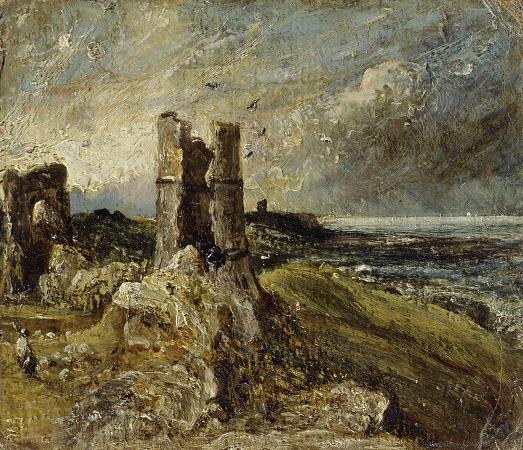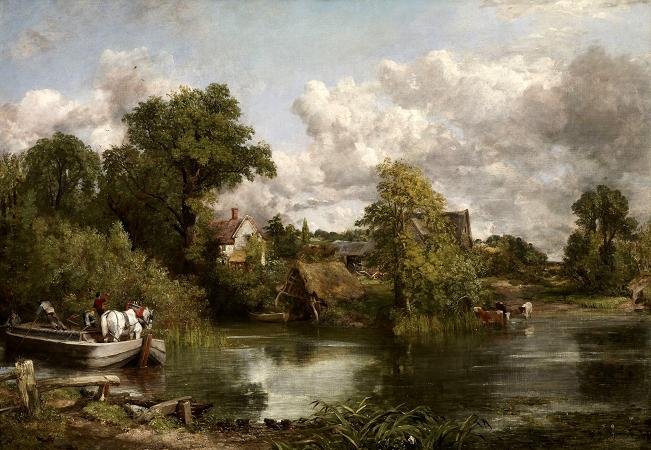Hadleigh Castle (1829). Oil on canvas. 122 x 165. Hadleigh Castle is a ruined medieval fortification located in the English county of Essex. One of the earliest depictions of the castle is a drawing by the antiquarian John Leland, which dates from around 1540. The drawing shows the castle as it would have appeared in the 16th century, with its towers and walls still intact. In the 18th and 19th centuries, Hadleigh Castle became a popular subject for landscape painters, who were drawn to its picturesque ruins and dramatic setting. One of the most famous paintings of the castle is by J.M.W. Turner, who painted several views of the castle in the early 19th century. Turner's paintings of Hadleigh Castle are notable for their use of color and light, as well as their romanticized depiction of the castle as a symbol of past glories. Another notable painting of Hadleigh Castle is by John Constable, who painted the castle from a distance in his famous work "Hadleigh Castle, The Mouth of the Thames – Morning after a Stormy Night" (1829). In this painting, the castle is shown as a small, distant figure against a backdrop of stormy skies and turbulent waters. The painting is notable for its dramatic use of light and shadow, as well as its evocation of the power and unpredictability of nature. In recent years, Hadleigh Castle has continued to be a popular subject for artists and photographers. The castle's ruins and dramatic setting make it a popular destination for landscape photographers, who often capture the castle at sunrise or sunset. The castle has also been used as a backdrop for music videos and films, including the 2012 Olympics opening ceremony, which featured a segment filmed at Hadleigh Castle. Hadleigh Castle in the English county of Essex overlooks the Thames estuary from a ridge to the south of the town of Hadleigh. Built after 1215 during the reign of Henry III by Hubert de Burgh, the castle was surrounded by parkland and had an important economic, as well as defensive role. Hadleigh was significantly expanded by Edward III, who turned it into a grander property, designed to defend against potential French attack as well as provide the king with a convenient private residence close to London. Built on a geologically unstable hill of London clay, the castle has often been subject to subsidence; this, combined with the sale of its stonework in the 16th century, has led to it now being ruined, although what remains of it is now preserved by English Heritage as a Grade I listed building and scheduled monument. Hadleigh Castle was first built by Hubert de Burgh, the 1st Earl of Kent, who was a key supporter of King John. De Burgh was given the honour of Rayleigh by John in 1215 as a reward for his services, but chose not to develop the existing caput of Rayleigh Castle, instead building a new fortification south of the town of Hadleigh. The exact date of construction is uncertain, but it is now believed the work was conducted early in de Burgh's tenure of the site, permission being retrospectively officially confirmed through a license to crenellate in 1230 under Henry III. The site was chosen on top of a local ridge, overlooking the Thames estuary, formed from a geologically unstable outcrop of London clay. In the 13th century, marshlands would have stretched away to the south of the castle, with the tide occasionally reaching up as far as the base of the hill itself, and the area would have been more wooded than today. By 1235 the park of Hadleigh had been formed around the castle, including woodland, a fishpond, stables and a park lodge, but the castle was also associated with a wider estate including Rayleigh, Thundersley and Eastwood Parks. The first castle built on the site was probably of an octagonal design, running along the top of the ridge, protected by square and semi-circular mural towers, with a barbican guarding the eastern entrance. It probably resembled White Castle, remodelled by de Burgh in the same period, or Bolingbroke and Beeston Castles, both built in the 1220s. The castle was built of Kentish ragstone and cemented by a mortar containing a large proportion of seashells, particularly cockleshells from the cockle beds of neighbouring Canvey Island.
more...







